Strawberry is an essential small fruit crop grown worldwide due to its rich sources of vitamins and abundant antioxidants. The leading strawberry-producing states are California, followed by Florida, which produces more than 90% of the strawberries in the US. The plant has a short stem and trifoliate leaves, which form a crown. Close to the ground.
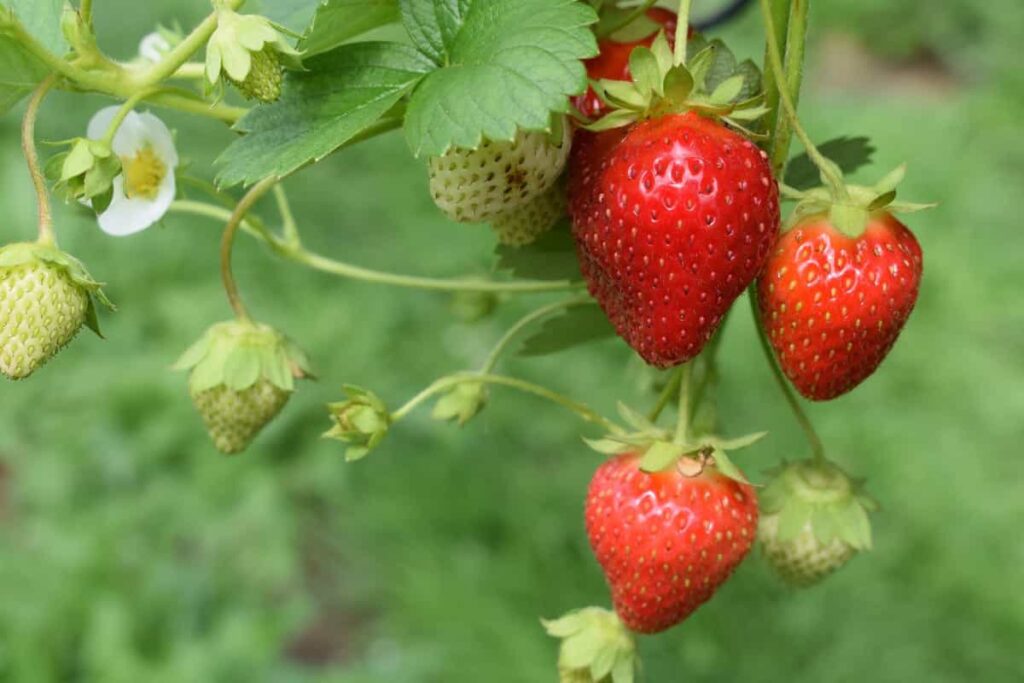
The leaves display a variety of characteristics depending on the species, and some are evergreen, whereas some have leaves that will die and fall off in winter. The plant produces flower stalks from the crown, and the flowers are white. The plant’s fruit is red and fleshy with tiny seeds on the outside. Strawberry can grow 20–25 cm in height and has an economic life of 2–4 years before replacing the plants.
How to control pests and diseases in strawberry crop
A host of arthropod pests, including insect and mite species, often threaten strawberry production. Some major arthropod pests affecting strawberry production include two-spotted spider mites, thrips, Frankliniella and Scirtothrips spp., armyworms, and root-boring pests. And many different hemipterans cause injury to the strawberry leaf and fruit, including the tarnished plant bug. Below are the commonly occurring pests and diseases in the strawberry crop,
Pests and insects
Thrips
It is a tiny insect that feeds on flower parts. Several species occasionally infest strawberry flowers. In spring, these insects breed on grasses and weeds before moving to strawberries. They lay their eggs in plant tissue at the base of flowers and tender new foliage. After the buds open, thrips begin feeding on the seeds and the inner surface of the hull. Finally, thrips feed on the fruit between the seeds as the fruit expands and the seeds separate.
Damage symptoms
- Thrip nymphs and adults injure plants by rasping bud, flower, and leaf tissues, then sucking sap from the exuding tissues.
- When thrips feed on strawberry blossoms, the stigmas and anthers turn brown and wither prematurely, but not before fertilization.
- When populations are high, the surface of the berries may become cracked and discolored.
- From late green to ripe fruit, surface russeting can be observed around planting materials. The fruit can take on a seedy bronze appearance because of this.
- Thrip larvae and adults will be sucking on the fruits.
In case you missed it: How this Farmer Earning 18 Lakhs from His Strawberry Farm: A Success Story of a Fruit Farmer in India
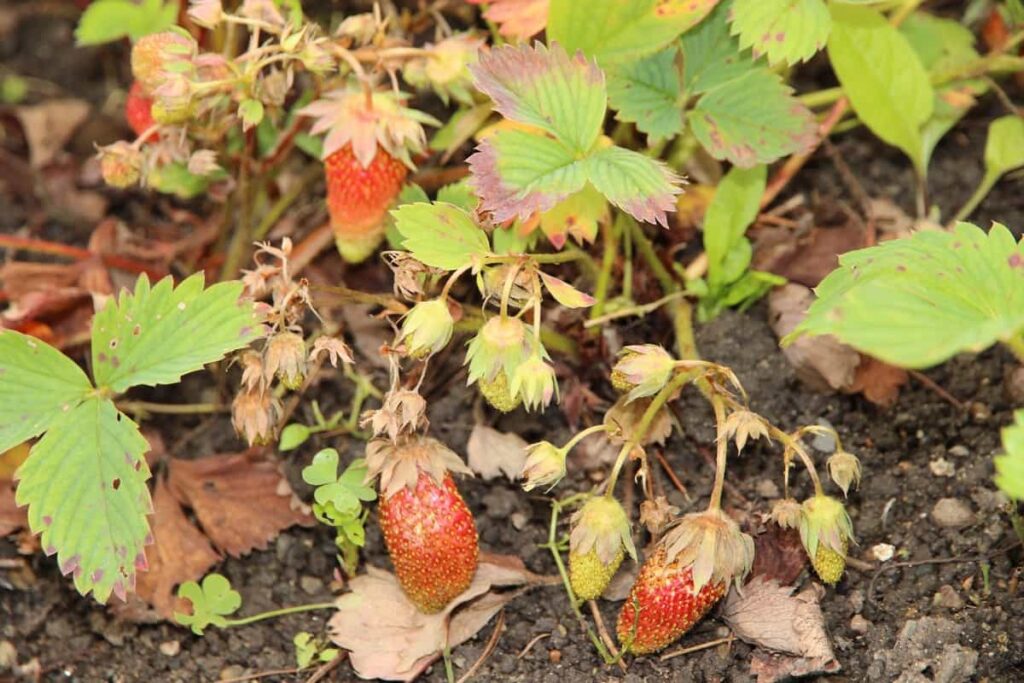
Biological Control
- Naturally occurring minute pirate bugs feed on thrips. Orius are also available commercially, but release rates and timing have not been determined.
- Predatory thrips, green lacewings, minute pirate bugs, mites, and certain parasitic wasps help to control plant-feeding thrips.
Chemical controls
- Use sprays of the Entrust formulation of spinosad, azadirachtin, Beauveria bassiana, or combinations of these products on organically certified strawberries.
- Use these insecticides for controlling thrip are spinetoram, malathion, acetamiprid, pyrethrin, pyrethrin or piperonyl butoxide
Whiteflies
Greenhouse whitefly numbers tend to increase in fall, reaching peak densities in late fall through winter. It can take whiteflies as little as 18 days to complete a generation when the weather is warm. Whiteflies are easily distinguished from other insect pests: adults of all species are about 1 mm in size with four membranous wings coated with white powdery wax.
Damage symptoms
- Greenhouse whiteflies can transmit viruses, and virus decline in strawberries has been linked to them.
- As whiteflies feed on leaf sap, they may reduce crop yields directly and stunt plant growth.
- Additionally, they produce sticky honeydew during feeding. As a result of honeydew covering plants, black sooty mold can grow on them.
- Premature defoliation occurs when there is a severe infestation
Chemical control
- An application of imidacloprid can control when whitefly numbers begin to increase. However, controlling adult whiteflies will take about 2 to 3 weeks following application, so apply before whitefly numbers increase significantly.
- Fenpropathrin is a pyrethroid, and malathion is an organophosphate. Therefore, the use of fenpropathrin is limited to two applications per year.
Biological Control
In most crops, greenhouse and iris whiteflies are generally controlled by naturally occurring parasitic wasps and general predators.
- Natural enemies of whiteflies include parasitic wasps of the genera Encarsia, Eretmocerus, Prospaltella, big-eyed bugs, pirate bugs, and lacewing larvae.
- Encarsia Formosa is used worldwide for greenhouse whitefly suppression in greenhouses. Still, more research is necessary to determine if the release of this or other parasites can help prevent whiteflies from increasing in numbers in field situations.
In case you missed it: How to Start Strawberry Farming in the USA: A Step-By-Step Production Guide to Planting to Harvesting
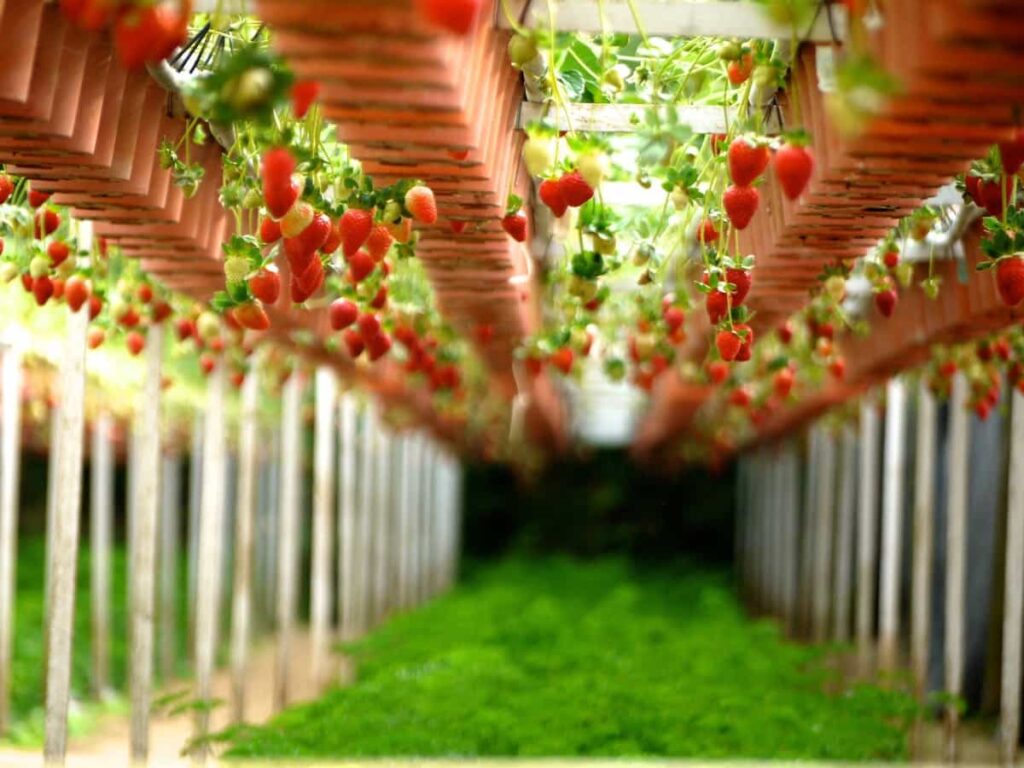
Tarnished Plant Bugs
The western tarnished plant bug attacks strawberries. The adults appear nomadic, moving from one plant to another as each plant begins to flower. Overwinter as adults in weeds. When the rains cease and the weeds dry out in spring, the adults rapidly colonize strawberries. Whereas strawberries are not a preferred host of these pests, the absence of other more attractive plants in late spring is perhaps the basis for the extensive colonization of strawberries. At least two generations develop between April and August in strawberries in this area.
Damage symptoms
- Tarnished plant bug feeding produces distorted or “cat-faced” fruit. This damage is due to seed feeding by nymphs or adults as the fruit develops.
- Damaged seeds are frequently brown on the outside and hollow on the inside.
- Day-neutral or everbearing strawberries may be more severely affected. However, other factors, such as poor pollination, can cause misshapen fruit, so the presence of misshapen fruit does not always indicate a problem with tarnished plant bugs.
- Poor pollination is often very common in the first picking of spring fruiting strawberries in the southeast, when weather is often less suitable for bee activity
Chemical control
- The insecticides in strawberries include organophosphates, malathion, naled, and carbamate methomyl.
- The pyrethroids, fenpropathrin, and bifenthrin. The pyrethroids provide control for extended periods, but there is concern about their negative impacts on existing natural enemies.
- Several pyrethroids are labeled, with varying pre-harvest intervals. Malathion is also labeled, as is Assail.
Biological control
- Naturally occurring predators at risk include big-eyed bugs, Geocoris spp., minute pirate bugs, Orius spp., green and brown lacewings, and Chrysoperla.
- Hemerobius species, damsel bugs, Nabis species, convergent lady beetles, and several species of spiders feed on white flies and lepidopteran pests, as well as Lygus nymphs and eggs.
- Adult tarnished plant bugs can be monitored with white sticky traps. The purpose of these traps is to detect when plant bugs are active in the spring, not to control them.
The two-spotted spider mite
Strawberries and various other crops can be infested with the two-spotted spider mite. Other weeds that contain it include Black Nightshade, small stinging nettle, and gallant soldier. In the crops, the adult females overwinter in sheltered places. They become active in spring. They are easy to recognize not because of their color but because of two black spots on their bodies. In addition to eggs, larvae, protonymphs, deutonymphs, and adults, there are five stages of development. The life cycle will take 5-20 days, depending on the temperature.
Damage symptoms
- Leaf surfaces are rasped away by spider mites to feed on plant sap
- There is speckling and mottling on leaves as the first sign of damage.
- A heavy infestation results in purple leaves with white webbing between them.
- An infestation of more than 75 mites per leaflet can severely weaken plants and cause them to look stunted, dry, and red.
- Leaves that have been severely damaged die and fall
Biological control
- Phytoseiulus persimilis, Neoseiulus californicus, Neoseiulus fallacis, and Galendromus occidentalis are the most commonly used predatory mites for spider mite suppression.
- Phytoseiulus persimilis P persimilis feeds aggressively, multiplies rapidly, and is a specialist predator that feeds exclusively on pest mites.
In case you missed it: Top 20 Steps to Boost Strawberry Yield: How to Increase Strawberry Production
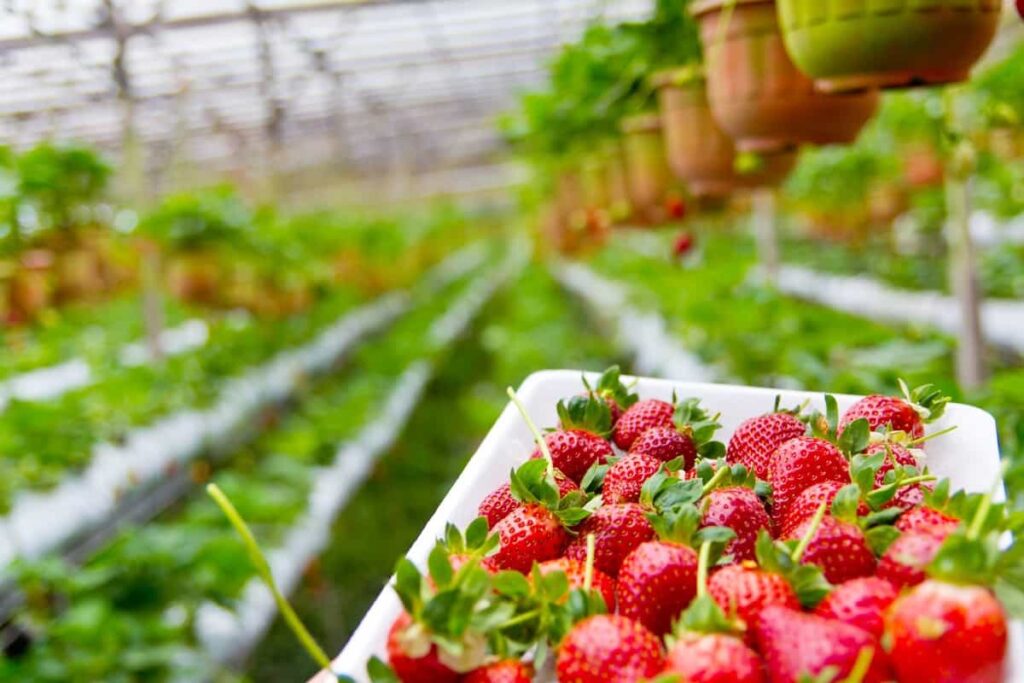
Chemical control
- Cyflumetofen- Do not make more than one application before using an effective miticide with a different mode of action for resistance management.
- Acequinocyl- It cannot be applied more than twice a year. A minimum of 21 days should pass between treatments.
- Spiromesifen- Do not make more than two applications per crop season.
- The most effective way to kill eggs and immature mites are with etoxazole.
Root-knot nematode
It is a microscopic organism. The first molt occurs within the egg during the first larvae development stage. After hatching from eggs, second-stage larvae find and infect plant roots or, in some cases, foliar tissues. Within 4 to 8 weeks, depending on the temperature, the eggs hatch, and larvae emerge to complete the life cycle. The optimal soil temperature range for nematode development is 21°C to 26°C
Damage symptoms
- Patches of infected plants in the orchard
- The initial symptom is the formation of galls on the host root system
- Infected roots become knobby and knotty when they branch profusely from the gall tissue
- Severely infected plants have a reduced root system and almost no rootlets. The roots severely hinder the uptake and transport of water and nutrients
- A nematode infection predisposes plants to be bacterial and fungal root pathogens
Biological control
- Since chemical nematicides are highly toxic, new control strategies are needed for nematodes. A filamentous fungus can be a promising biocontrol agent in this regard.
- The genus Trichoderma, mycorrhizal and endophytic fungi are the main filamentous fungi studied and used as biological control agents against nematodes as resistance inducers. They can directly reduce the damage caused by plant-parasitic nematodes by parasitism, antibiosis, paralysis, and by producing lytic enzymes.
Chemical control
- Only strawberry nurseries can use methyl bromide through quarantine and pre-shipment exemptions.
- A liquid form of Chloropicrin that diffuses as a gas through the soil. It is very effective for the control of soilborne fungal pathogens and insects like nematodes.
Diseases in strawberry
Anthracnose
The anthracnose fungus attacks strawberries’ crowns, stems, leaves, and fruits. The orange ooze of spores recognizes anthracnose it forms on the parts of the plant it kills. Splashing water from overhead spreads these spores. So when there is no rain and no overhead watering after the fruit set, you can at least save the crop, although your plants may suffer.
Disease symptoms
- Three different fungal species can cause anthracnose, but all have similar symptoms:
- The spots appear water-soaked on green and ripe berries
- Each berry has several spots rather than just one large spot, as in Alternaria black spot. Fruit may appear mummified when dry
- Black flower petals that are dying or sunken
- A large area of brown or blackened leaves
Chemical control and management
- Anthracnose is primarily controlled with copper-based fungicides. Copper, however, can accumulate to toxic levels in the soil, harming earthworms and microbes.
- Removing infected plants and berries as soon as possible
- Control weeds regularly
- Keep air flowing by maintaining adequate thinning and spacing
- Straw mulches reduce the dispersal of spores
In case you missed it: How To Start Strawberry Gardening, Tips, Ideas
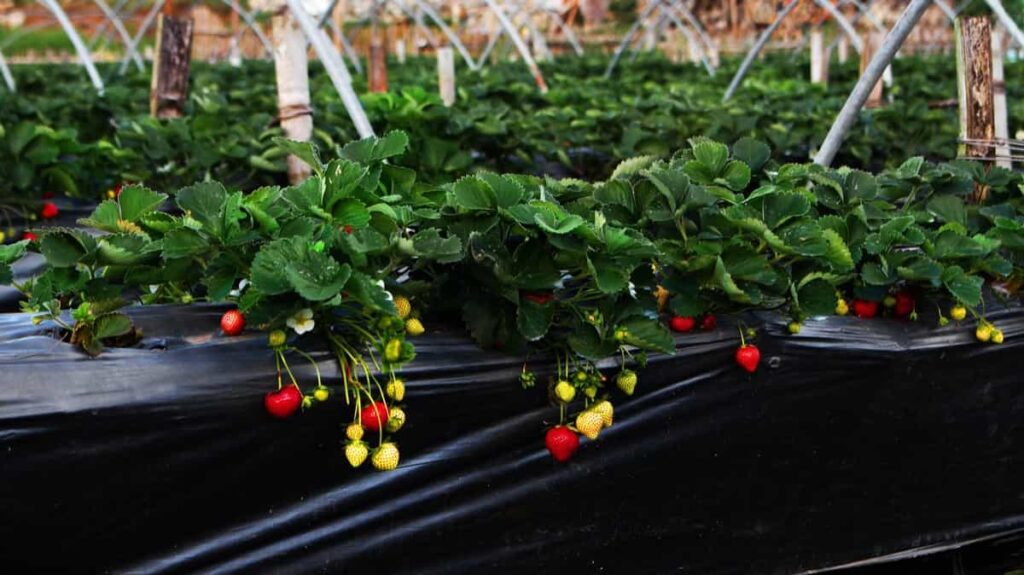
Powdery mildew
The powdery mildew usually attacks young, growing leaves, not mature leaves. Mildew colonies produce spores when they have taken over a leaf. Spores of these fungi land on flowers. White, fluffy patches cover the deformed flowers, and they do not develop properly, so they cannot bear fruit. Powdery mildew does not threaten the fruit after flowering but can infect the seeds a few days later. A mildew-affected strawberry has a “seedy” appearance and a moldy taste.
Disease symptoms:
- With the growth of mildew, lower surface leaves turn purple, then red, and upper surface leaves show purple, red, and brown blotches.
- An early disease symptom is the upward curling of the leaf margins.
- It is followed by irregular, purple blotching on the upper leaf surfaces, often along major veins. The leaves feel brittle.
- Powdery mildew can attack fruit at any stage.
- Dull immature and mature berries with prominent planting materials
Chemical control and management
- Apply micronized sulfur or some of the same soaps used for insect protection to prevent powdery mildew. Before powdery mildew appears, these relatively non-toxic products should be applied.
- A tablespoon of baking soda (about 15 grams) in 4 liters of water is also helpful.
Red stele/Red core
This root rot is caused by the soil-dwelling fungus Phytophthora fragariae. Healthy roots can be infected by spores that infected plants produce. These spores will move through the soil and penetrate the root tips, growing within the root system when they penetrate the soil. It takes a few days for the roots to rot after infection. These rotted tissues produce spores that are eventually incorporated into the soil along with the spores. In most cases, the diseased area in a bed follows a definite pattern.
Disease symptoms
- Older leaves turn yellow or red, particularly along the margin.
- The symptom that helps to identify red stele is the brick red discoloration in the center (stele) of live white roots.
- The red color may extend the length of the root or show up only a short distance above the dead root tip.
- Growth of the plants will slow down and become dull bluish-green. In spring, the plants will convalesce somewhat.
- An affected plant will form no or only a few flowers.
- The small fruits will dry out. The root-hair of the roots is lacking.
- When cutting the main roots, the central cylinder will appear discolored red.
Chemical control and management
- Apply Mefenoxam as a banded spray to soil or through drip up to 3 times starting at transplanting or after ground thaws before first bloom.
- Aliette and phosphorous acid fungicides can be applied as root dip, through a drip, and to foliage.
Botrytis Rot (Gray Mold)
Our lovely strawberries are among the 200 plants that host this gray mold. It is estimated that this mold can cause up to 80% loss of strawberry yields. A temperature range of 14°C to 22°C and a high humidity level are ideal for its growth. Before or after harvest, the fungus attacks ripe strawberries, causing them to become covered in unsightly fluffy gray mold.
Disease symptoms:
- The fungi will attack flowers, fruit, petioles, leaves, and stems
- Flowers and fruit stalks infected during flowering die rapidly. Green and ripe fruit develop brown rot
- It spreads over the whole fruit, which becomes covered with masses of dry, greyish spores
- The rot may start on any portion of the fruit but is found most frequently on the calyx end or the sides of fruit touching other rotten fruit
Chemical control and management
- Maintain adequate airflow between plants
- Don’t compost infected or dead plant material. Remove and destroy it.
- Natural fungicides such as neem oil can be used preemptively and after infection. Spray the diluted neem solution directly on plants to reduce the risk of botrytis outbreaks.
- Copper-Soap fungicides will help by protecting plants from disease spores. Apply at the start of flowering and continue every 7-10 days until harvest.
Leaf Spot
In late spring, strawberries are especially susceptible to this disease due to extended wet periods. The disease is caused by Mycospharella fragarieae, spores that blow into your garden or spread from dead foliage overwintered. Fortunately, leaf spot is a cosmetic problem that doesn’t usually affect your yields or fruit. However, when it spreads, it can manifest as red-looking strawberry leaves.
In case you missed it: Strawberry Farming Project Report, Cost, Profit Guide
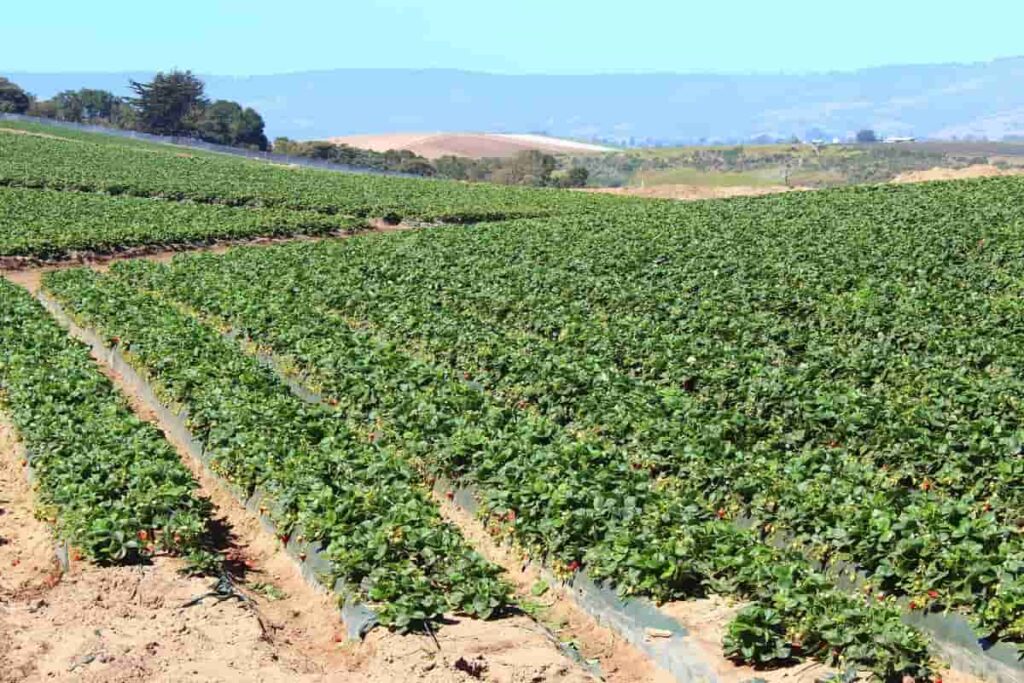
Damage symptoms
- The symptoms can also appear on fruits, berry caps, and runners. However, the signs of leaf spots must be distinguished from those of blights and pests.
- The spots may later turn into tan or white centers with rusty-brown margins
- Fruits with shallow black spots (up to 14 inches)
- Fruits with a leathery texture near spots are black or brown
Chemical control and management
- At the end of the season, remove all old plant material
- After plants finish fruiting, mow them down to encourage new growth
- Overhead irrigation should be avoided
- Ensure adequate airflow between plants
- Fungicides based on chlorothalonil, myclobutanil, or triflumizole can control common leaf spot disease on strawberries after the appearance of the first symptoms.
Conclusion
Strawberry diseases can affect the fruit, flowers, leaves, roots, and crowns of strawberry plants along with pests and sometimes cause the collapse of the whole plant. At the same time, many problems caused by bacteria, fungi, molds, and viruses can be treated when symptoms are observed. You should know about infection signs and their control methods to prevent them at the initial stages.
- Types of Pesticides Used in Agriculture: A Beginner’s Guide
- Economical Aquaculture: A Guide to Low-Budget Fish Farming
- 15 Common Planting Errors That Can Doom Your Fruit Trees
- How to Make Houseplants Bushy: Effective Tips and Ideas
- Innovative Strategies for Boosting Coconut Pollination and Yield
- Pollination Strategies for Maximum Pumpkin Yield
- The Complete Guide to Chicken Fattening: Strategies for Maximum Growth
- Natural Solutions for Tulip Problems: 100% Effective Remedies for Leaf and Bulb-Related Issues
- Revolutionizing Citrus Preservation: Towards a Healthier, Greener Future
- Natural Solutions for Peony Leaf and Flower Problems: 100% Effective Remedies
- Maximizing Profits with Avocado Contract Farming in India: A Comprehensive Guide
- Natural Solutions for Hydrangea Problems: 100% Effective Remedies for Leaf and Flowers
- The Ultimate Guide to Choosing the Perfect Foliage Friend: Bringing Life Indoors
- From Sunlight to Sustainability: 15 Ways to Use Solar Technology in Agriculture
- The Ultimate Guide to Dong Tao Chicken: Exploring from History to Raising
- The Eco-Friendly Makeover: How to Convert Your Unused Swimming Pool into a Fish Pond
- Mastering the Art of Delaware Chicken Farming: Essentials for Healthy Backyard Flocks
- 20 Best Homemade Fertilizers for Money Plant: DIY Recipes and Application Methods
- How to Craft a Comprehensive Free-Range Chicken Farming Business Plan
- Brighten Your Flock: Raising Easter Egger Chickens for Beauty and Bounty
- How to Optimize Your Poultry Egg Farm Business Plan with These Strategies
- Subsidy for Spirulina Cultivation: How Indian Government Schemes Encouraging Spirulina Farmers
- Ultimate Guide to Raising Dominique Chickens: Breeding, Feeding, Egg-Production, and Care
- Mastering the Art of Raising Jersey Giant Chickens: Care, Feeding, and More
- Ultimate Guide to Raising Legbar Chickens: Breeding, Farming Practices, Diet, Egg-Production
- How to Raise Welsummer Chickens: A Comprehensive Guide for Beginners
- How to Protect Indoor Plants in Winter: A Comprehensive Guide
- Ultimate Guide to Grow Bag Gardening: Tips, Tricks, and Planting Ideas for Urban Gardeners
- Guide to Lotus Cultivation: How to Propagate, Plant, Grow, Care, Cost, and Profit
- Agriculture Drone Subsidy Scheme: Government Kisan Subsidy, License, and How to Apply Online
- Ultimate Guide to Raising Araucana Chickens: Breed Profile, Farming Economics, Diet, and Care
- Bringing Hydroponics to Classroom: Importance, Benefits of Learning for School Students
- Ultimate Guide to Raising Polish Chickens: Breed Profile, Farming Economics, Diet, and Care
- Ultimate Guide to Raising Australorp Chickens: Profile, Farming Economics, Egg Production, Diet, and Care
- Silkie Chicken Farming: Raising Practices, Varieties, Egg Production, Diet, and Care
- Sussex Chicken Farming: Raising Practices, Varieties, Egg Production, Diet and Care